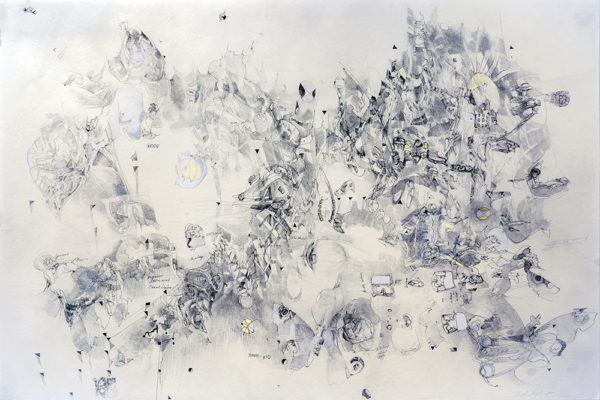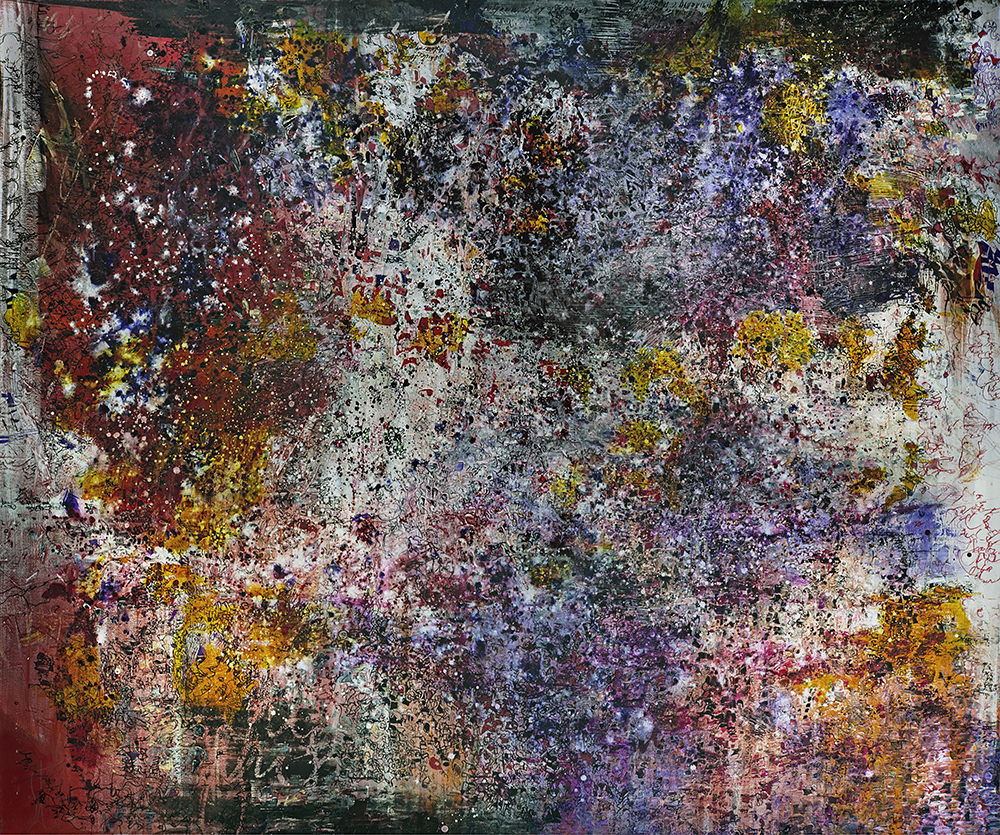I’m looking at Second Sight (2016) by Christina McPhee, which carries the same title as her solo exhibition currently on view at Cerritos Art Gallery. This work is an abstract, dense and expressive work on paper: there are marks upon marks, which create a layered effect, there are repetitive movements that create structural and biomorphic forms, and there are intensely dark areas in proximity to lighter, grayer, areas. Also, this work seems to move, to pulsate—in that the foreground, middle ground, and background trespass each other. In viewing this non-figurative image, it nevertheless surfaces a body, which I will get into more detail below. In closely looking at it, I could simultaneously hear McPhee drawing and scribbling rapidly—a synesthetic experience happened—upon looking at Coral Bones (2016). And, it was in this moment and movement that a memory was evoked—what Roland Barthes calls a “punctum”: the sudden recollection that punctured me, that created a hole that drew me into a memory.

Second Sight
I am a young boy sitting on the floor—decades ago. My mother is writing a letter, in the silence of the space we occupy, I can hear her fountain pen scraping across the paper—indenting it. The pen dances across the white, pressed cotton surface. In this dance, there were sped-up parts, and there were pauses. At points the movement stopped, and then immediately started again, the pen point cut deep and moved towards tender moments. Here, back at the gallery again, I am looking at the image. In front of it I had a second sight—another vision. In many ways, McPhee’s work is about what has been—but it does not resist or foreclose a future. And, this is what I pick up on—or what picks me up and carries me away—and I am shuttled back and forth, all the while moving toward the Open that we call the future (that will be filled with other moments that turn into memories, encounters—in a word, the Unknown). Oddly this embodied feeling of a Barthsian punctum happened to me with several of the artist’s works: as I said before Coral Bones (2016) Data Points Spring (2016) and Arm of the Starfish (Termeridad) (2016)—both of which are intense, abstract drawings that pulled me into its eccentric vortex.
Arm of the Starfish (2016), there are flurries of mark makings that fill the surface, but this time there are various hues of blue (connoting the ocean?) and there is also text, which rests between an abstract background—and it is important to note that the handwriting blends in perfectly with the abstract lines that create the total image.

Arms of the Starfish, graphite, ink, and colored pencil on takefu paper
McPhee’s drawings move, bend and fluctuate: they are, in part, about movement. This becomes more apparent in Data Points Spring (2016). In this image there is an overall movement, that when viewed farther away from, looks like a Möbius stripe in motion. There are also notes on this moving image. According to McPhee, the “notations derive from the ‘beach ball’ visualization of strike/slip moment tensors in earthquakes along the San Andreas Fault.” This stated, nearly all of the artist’s works reckon with the environment and how it is destroyed by human actions, which can be seen, abstractly, from Autotune Troika Coral Reef Bones, numbers 1 and 2 (2016), which highlights, with the use of a chemical looking yellow-green pigment, the toxic cleaning of the ocean after an oil spill.
Here, I turn to her aesthetically astute paintings, such as Glyphosate Garden Wars (2016) and Prison Prism (2016), which are strong representatives of her latest work. These works are colorful and expressive. Prison Prism seems to be an explosion of brilliant colors radiating outward: beauty in destruction? Overall, her paintings are expressive in another way, they are energetic in an outward way—aimed toward the viewer, as if to envelope them in a marvelous array of colors beaming from a prism.
McPhee’s Glyphosate Garden Wars, seems to be a continuation of the dynamism of Futurism without the masculinist tendencies. It looks like a otherworldly city, one that is to come, and it is this “to come” that I tie McPhee’s work to queer futurity where “chononormativity,” if you will, is replaced by other senses of time. And it is the use of abstraction, color, political critique that I see McPhee’s work as an engagement in both queer abstraction, futurity and feminism. I use the word “queer” to specifically mark them as being in opposition to the history, linage and inheritances of abstraction.[i]

Data Points Spring, graphite,ink, china marker and colored pencil on takefu paper
25 x 38 in
With the use of so much dark drawing materials, such as oil paint, graphite, ink, and oil paint added, there is a melancholic air around most of the art. In the darkest aspects of any of McPhee’s drawings, there are points of illumination piercing through, but this should not be read in any binary way (her work is too complicated for that), but rather in a way that highlights the “beside”—how they reverberate against each other and what such a juxtaposition can highlight. According to the press release, “[McPhee’s] work takes on violence, tragi-comic exuberance, and vitality from a ‘post-natural’ experience of community”—which we see from the dark abstract drawings to the works reckoning with the violence done against nature. To be sure, this raises visualities and theories, which I mention above gesture to above, and what I call, second-wave queer theory.
Aiming toward a closing of this rich body of work, I should like to surface McPhee’s artwork and how it surfaces the body, as well as what I call “queer abstraction”—which doesn’t denote LGBT identities or sexual object choices, but rather the works affordance to open up to ways of seeing peculiarly that are not aligned with traditional articulations of abstract art and its (proper) historical (read masculinist) lineage.
All of the images in “Second Sight,” I recall the image of feminist artist Carolee Schneeman’s Up To and Including Her Limits (1973–76), in which Schneemann is swung around while she makes marks on paper,[1] which trace the movement of her body, or Shigeo Kubota’s (in)famous Vagina Painting (1965), in which she paints, as the title suggests, with her vagina—hence, both artists critiquing dominate abstract expressionism.[ii] Indeed, there is a feminist genealogy here, but there is also a queer one—for example, Andy Warhol’s Oxidation Painting (Piss Painting) of 1978, in which he and others would piss on copper plates to patina them, which of course can be read, as too the women artists, as a critique of masculine bravado of Jackson Pollock flinging paint with his metaphorical dick.[iii] This said, I read Christina McPhee’s work as drawn performances—and queer-feminist ones at that because, just as I stated at the beginning of this review, her work moves and is abstract, and, as I argue here, queer, because according to Eve Sedgwick, “queer is an open mesh of possibilities, gaps, overlaps, dissonances and resonances, lapses and excesses of meaning”—which relate to McPhee’s work as whole.[iv] Queer is about flux, flow and dispersal of all monoliths. And feminist art practices, as mentioned above, undermines the long history of abstraction, which is usually tied, at least in dominant art history, to the male artist. Thus, McPhee’s work can be seen as an enactment of a queer-feminist abstraction—and an abstraction that deserves more than just a formal reading, but rather a deep engagement into philosophical and theoretical ideas.
“Second Sight” is an exhibition that highlights how abstraction can be done today without relying on the usual tropes. It shows that everything from environmental to sex and gender concerns can be reckoned with in very powerful and visually profound ways that show there is a future ahead of us—that it is not behind us, and we can, even in dark times, and with daunting issues, overcome and move forward. In the end, this is an inspiring exhibition—one that should not be missed.
[i] Please see my unpublished paper “Queer Abstraction” on academia.edu.
[ii] See Amelia Jones, Body Art: Performing the Subject (Minnesota: University of Minneapolis Press, 1998).
[iii] In 2010, Christina McPhee combined footage she shot at oil fields in California with a remix of Carolee Schneeman’s film, Meat Joy (1964), in the short video, MEAT OIL JOY PAINT: A Tribute to Carolee Schneeman, most recently shown in October 2016 in London, at The Horse Hospital, curated by the Center for Visual Music, Los Angeles.
[iv] Eve Sedgwick, Tendencies (Durham: Duke University Press, 1993), 8. I am also drawing on my unpublished paper, “Queer Abstraction”.
“Second Sight: New Work” by Christina McPhee
September 8 to December 12, 2016 (Weekdays 11-4PM
Book Release: Saturday, November 12, 2016 from 4-6PM
Cerritos Art Gallery 11110 Alondra Blvd, Norwalk, CA 90650
http://www.cerritosgallery.com/
Closing & Book Release: Saturday, November 12, 2016 @ 4-6PM
In addition to the exhibition catalog for SECOND SIGHT, the closing reception will debut the newly published text Christina McPhee: A Commonplace Book, published by Punctum Books and edited by Eileen A. Joy, with contributions by Judith Rodenbeck, Ina Blom, Phil King, Frazer Ward, Melissa Potter and others.


